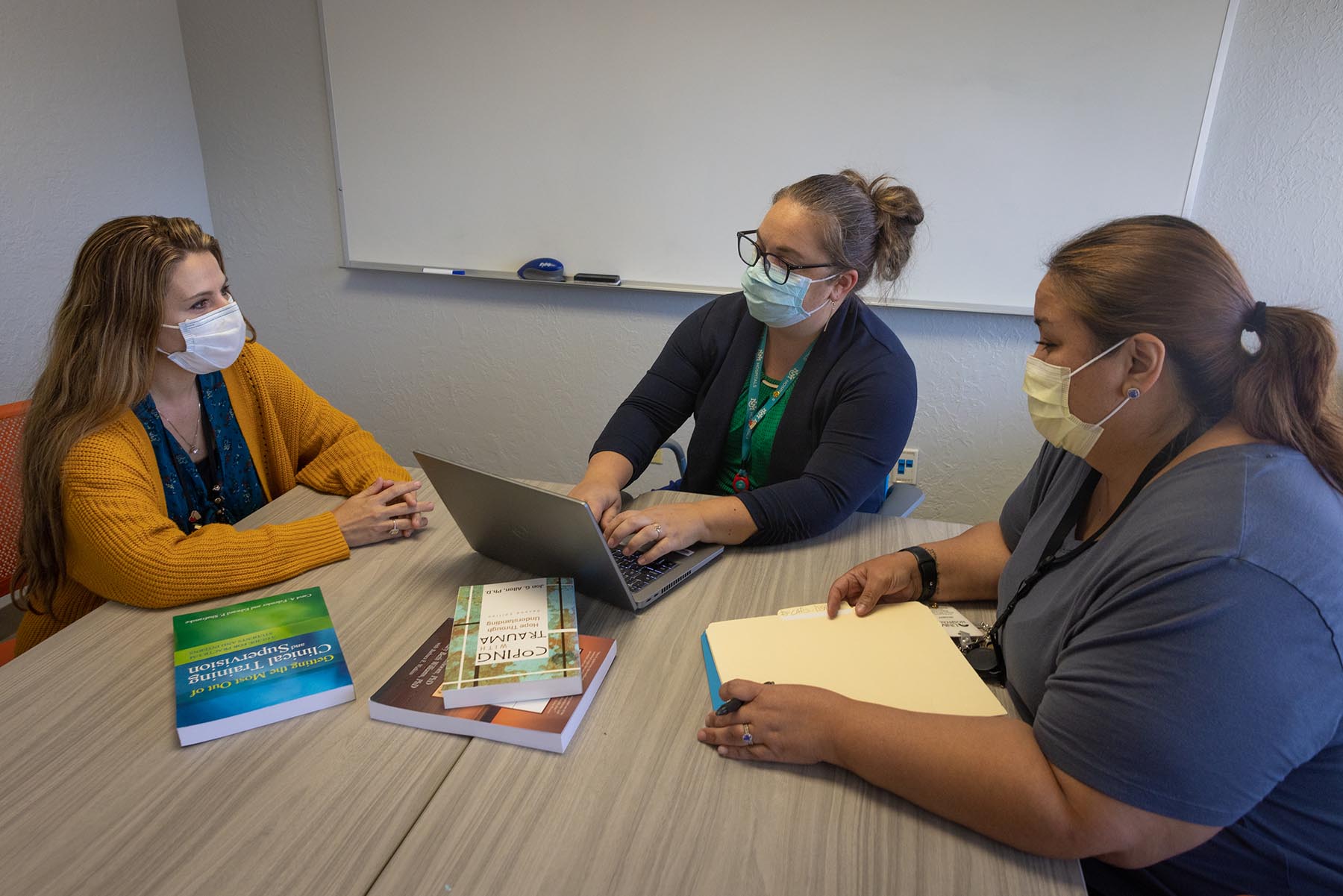Substance use is a significant public health issue in New Mexico, which for decades has ranked among the worst states in the nation for alcohol- and drug-related deaths.
Cases of substance use disorders continued to skyrocket in 2020 during the COVID-19 pandemic, where the isolation and loneliness that accompanied lockdowns, often exacerbated people’s mental health challenges.
While the situation across the state is dire, a ray of hope for people with severe substance use disorders can be found in a relatively nondescript building on Yale Boulevard, near the Albuquerque Sunport.
More than 700 patients have been able to find solace and recovery within The University of New Mexico Addiction & Substance Abuse Program (ASAP) Clinic this year alone.
The Clinic
ASAP is a multidisciplinary treatment facility focused on treating substance use disorders through integrated evidence-based care.
The clinic, located at 2600 Yale Blvd. SE, offers case management, medication-assisted treatment (including opioid replacement therapy), outpatient detoxification, primary care services (including hepatitis C treatment), psychiatric services and group, individual, family and couple psychotherapeutic services. It also offers specialty addiction treatment, including services for pregnant, adolescent and transition age people, and individuals with severe mental illness and/or trauma.
At intake, each patient is evaluated to see how their individual treatment plan should be drawn up.
“There’s a nurse assessment that’s done and then a clinical assessment that’s done,” said ASAP nursing supervisor Violeta Duran, RN. “Then, if needed, there’s a medical assessment that can be done. Based on those assessments, treatment is then tailored for each patient.”
ASAP team members, including intake assessment, behavioral health and counseling, clinical and case management, pharmacotherapy, peer support groups and medical services – including hepatitis C providers – bring their perspectives and ideas to the table to collectively formulate a patient’s plan.

I do think that we set the standard for what is effective substance use disorder treatment. I don’t know of any other program in the region that is doing what we are doing. I think that even within our own organization, we’re a standard for how to work from a multidisciplinary perspective.
“I do think that we set the standard for what is effective substance use disorder treatment. I don’t know of any other program in the region that is doing what we are doing,” said Larissa Lindsey, PhD, ASAP’s clinical services director. “I think that even within our own organization, we’re a standard for how to work from a multidisciplinary perspective.”
One of the most important aspects of the care administered at ASAP, according to Lindsey, is nurse leadership – specifically the nurses involved with the engagement teams who have day-to-day contact with the patients.
“There’s no way that we would be able to treat the patients as effectively or be able to work with this level of acuity at an outpatient level if it wasn’t for the nurse teams,” Lindsey said. “These nurses get to know the patients really well and put that dedication into getting these people to come in and get care.”
Three Stages
There are three stages of care at ASAP. At stage 1, patients gain skills needed to become stable and begin recovery. At the second stage, they begin to work on healing from the things that caused substance use in the first place. And in the final stage, patients work on re-integration (or sometimes integrating into society for the first time) and finding out who they are without using substances.
It's during that third stage is when patients set vocational, educational, interpersonal and medical goals before graduating from the ASAP program.
“We try to show them how to get engaged with things that actually maintain recovery, because it’s not sobriety; it’s things like having purpose and having meaning,” Lindsey said. “We really focus on how to get people stable for the long term, and then graduate them to whatever level of services in the community are going to keep them there at that level.”
For the most part, ASAP provides patient care to people who have severe substance use disorders, Lindsay said.
“Only the really, really sick people need to come to us,” she said. “The rest of people with substance use disorders can usually be treated by their primary care physicians.
Stigma
A report presented to the New Mexico Legislative Finance Committee in 2021 estimated there are more than 100,000 people in the state living with untreated substance use disorders. This is driven, in part, by the stigma associated with addiction.
Because this often prevents people from seeking help, the ASAP team approaches each patient with empathy and understanding.
“They’re sick and they need help,” Lindsey said. “They deserve love and compassion and support, and they don’t deserve to be ostracized. We’re always trying to fight against that stigma, help our patients fight that stigma and help other providers fight that stigma.”
ASAP providers use “person-first” language when treating patients – which recognizes that the disorder is not as important as the person’s individuality and humanity. One example might be referring to a “person with an addiction” rather than “an addict.”
“Some people think that an ‘alcoholic’ looks like something, or that substance use is a moral failing,” said Alisa Damholt, ASAP’s clinical manager. “But when you switch that around, and call them an individual with a use disorder, people realize that it’s not a moral failing. It’s a medical disorder.”
Another common cause for stigma – and potentially a barrier for treatment access – is government regulation. Due to City of Albuquerque zoning codes, the clinic must be located where it is – away from schools and residences – because of the types of opioid replacement therapy medication administered there.
“But there’s no science to back that decision making,” Lindsey said. “That has nothing to do with the reality, which is that when you put programs like this in a community, it actually decreases crime and improves the community.”
Opioid Replacement Therapy
Opioid replacement therapy is an FDA-recommended treatment for addiction. It is highly effective when combined with counseling and other supports like case management and medical services.
ASAP offers three main types of opioid replacement therapy medications: methadone, buprenorphine and naltrexone.
“There are very effective medication options that really do help,” Lindsey said.
Methadone is slow acting and provides long lasting relief from opioid withdrawal symptoms for 24 hours or longer. Patients start on a low dose, with slow increases over time until reaching a comfortable dose. Methadone is typically not a short-term therapy, and many clients will remain on it for a year or more before tapering off their medication. However, some clients may remain on methadone for an indefinite time.
Buprenorphine works and is administered similarly to methadone, although the patient's degree of opioid dependence is a key factor on which drug to administer.
“Methadone is really a commitment,” Duran said. “You have to commit to coming every day and taking it every day and some people don’t.”
In that case, patients might be steered toward a different medication.
Naltrexone, which is used to treat alcohol use disorder as well as opiate use disorder, blocks the effect of opioid drugs and comes in both pill and injectable forms. The pill is taken daily, while the injectable (called Vivitrol) is administered once a month.
“If you don’t have insurance, Vivitrol is ridiculously expensive – around $1,500 a month – but Medicaid seems to pay for it, so that’s not such a big barrier for patients,” Duran said. “But if someone is paying out of pocket, they’d probably stick to the pill form, which is much more affordable.”
Most insurance companies, as well as Medicaid, cover the cost of opioid replacement therapy medication.
When used properly, opioid replacement therapy does not create a new addiction. Instead, it allows patients to regain a normal state of mind and can reduce withdrawals and cravings. Opioid replacement therapy administered at ASAP has allowed hundreds of people to return to work, school and family life.
Lindsey added that opioid replacement therapy is not trading one drug for another.
“We want people to understand that there’s a difference between addiction and dependence. It’s totally okay to be dependent on something if it keeps you healthy, like a person with diabetes being dependent on insulin,” Lindsey said. “For a lot of people, these are life-saving medications.”
ASAP’s History
The clinic’s beginnings go back about 30 years, when ASAP was still connected to the Center on Alcohol, Substance use, And Addictions (CASAA), a multidisciplinary research center at UNM whose offices are still next door to ASAP. In the beginning, ASAP was run by William Miller, PhD, distinguished professor emeritus of the UNM Department of Psychology.
“He is one of the founders for motivational interviewing, which is an international standard for working with not just substance use, but with any health change behaviors,” Lindsey said. “So, it’s kind of a big deal that he was part of our organization here.”
Motivational interviewing, or motivational enhancement therapy, seeks to avoid confrontation and elicit motivation with open-ended questions and empathy. And it was on this patient-centered approach that the clinic built its addiction and recovery treatment plans.
“We have a substance use issue here in our city and our state, but we do really great work here,” Lindsey said. “This staff is so committed to what they do, and I really think we’re the gold standard for treating patients with these disorders.”
